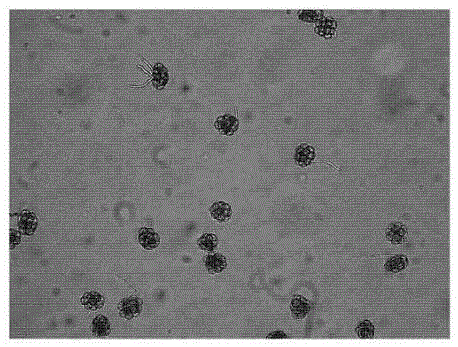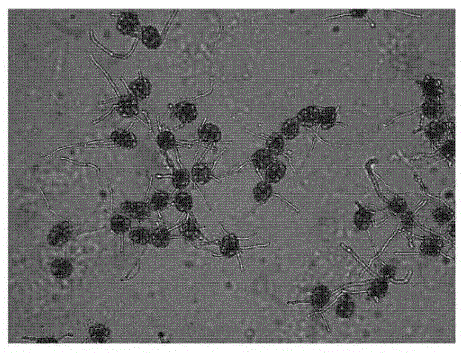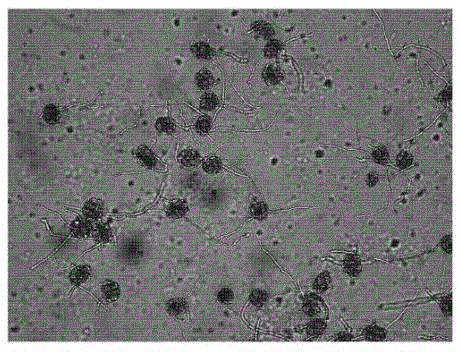Viability detection technology for acacia rachii pollen culture in vitro
A technology for in vitro culture and viability detection of pollen, applied in horticulture, botanical equipment and methods, horticultural tools/equipment, etc. Restrict the yield and quality of seed gardens, and achieve the effect of low natural pod setting rate, simple method, and high pollen sowing.
- Summary
- Abstract
- Description
- Claims
- Application Information
AI Technical Summary
Problems solved by technology
Method used
Image
Examples
Embodiment 1
[0032] During the blooming season of Acacia mazhan in late September, collect fresh flower branches containing many spikes that have not been interviewed by insects before 7 o'clock, put them in a small bucket with clear water, and bring them back to the laboratory for standby; use 20% Sucrose + 150mg / L boric acid + 0.25mmol / L calcium nitrate concentration to make a liquid medium, drop 3 drops in the groove of the concave glass slide, take the 2 segments of inflorescences that have been collected and cut into multiple segments, and clamp them in the medium with tweezers Rinse for 1 circle without covering the cover glass, then put the concave glass slide flat into a culture dish lined with wet filter paper, and keep the culture humidity at 26°C and the humidity at 85%. After culturing for 1.5, 4.0, 6.0, and 8 hours, put them under an optical microscope and observe the number of pollen germinations by conventional methods. The optical microscope pictures are respectively figur...
Embodiment 2
[0034] During the flowering season of the red bean acacia in mid-May, collect fresh flower branches containing many spikes that have not been interviewed by insects before 7 o'clock, put them in a small bucket with clear water, and bring them back to the laboratory for standby; use 15% sucrose + 100mg / L boric acid + 0.5mmol / L calcium nitrate to make a liquid medium, drop 2 drops in the groove of the concave glass slide, pick fresh inflorescences and cut them into multiple sections, pick up 3 sections with tweezers and rinse in the medium for 1 circle , do not cover with a cover glass, and then put the concave glass slide flat into a petri dish lined with wet filter paper, keep the culture humidity at 28°C, and the humidity at 88%, after culturing for 8 hours, place it under an optical microscope and observe it by conventional methods Germinated amount of pollen.
Embodiment 3
[0036] During the blooming season of the large-leaved straight-stalked acacia in early October, collect fresh flower branches containing many spikes that have not been interviewed by insects before 7 o'clock, put them in a small bucket with clear water, and bring them back to the laboratory for subsequent use; 18% sucrose + 130mg / L boric acid + 0.35mmol / L calcium nitrate concentration to make a liquid medium, drop 2 drops in the groove of the concave glass slide, take the 3 segments of inflorescences that have been collected and cut into multiple segments, clamp them with tweezers and culture them Rinse in the base for 1 circle, without covering the cover glass, then put the concave glass slide flat into a culture dish lined with wet filter paper, keep the culture humidity at 27°C, and the humidity at 90%, after culturing for 8 hours, place it under an optical microscope Next, the number of pollen germination was observed by conventional methods.
PUM
 Login to View More
Login to View More Abstract
Description
Claims
Application Information
 Login to View More
Login to View More - Generate Ideas
- Intellectual Property
- Life Sciences
- Materials
- Tech Scout
- Unparalleled Data Quality
- Higher Quality Content
- 60% Fewer Hallucinations
Browse by: Latest US Patents, China's latest patents, Technical Efficacy Thesaurus, Application Domain, Technology Topic, Popular Technical Reports.
© 2025 PatSnap. All rights reserved.Legal|Privacy policy|Modern Slavery Act Transparency Statement|Sitemap|About US| Contact US: help@patsnap.com



